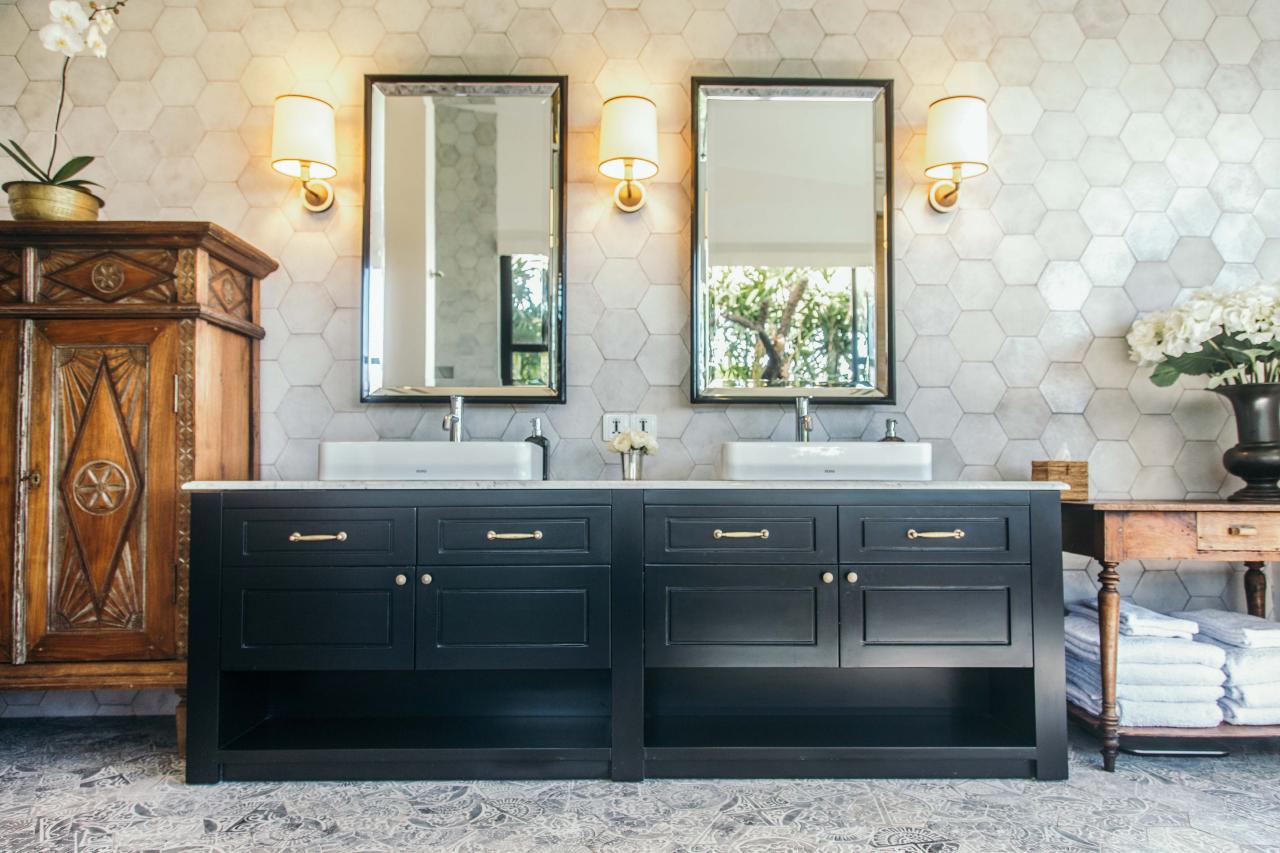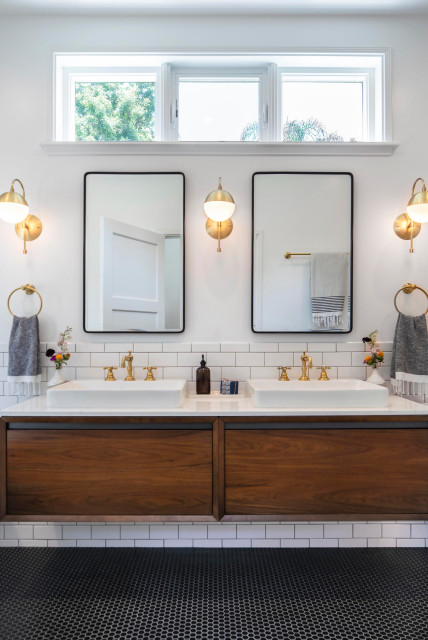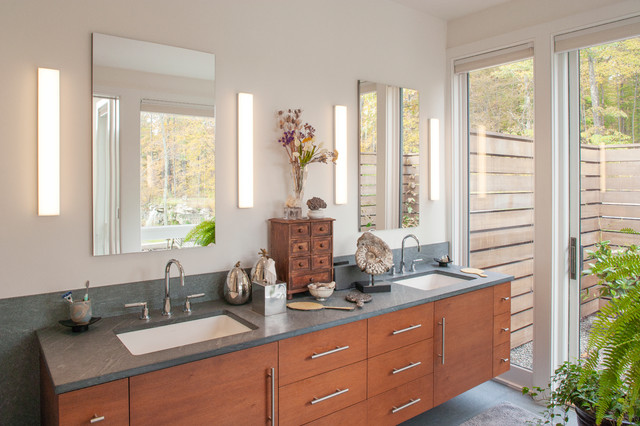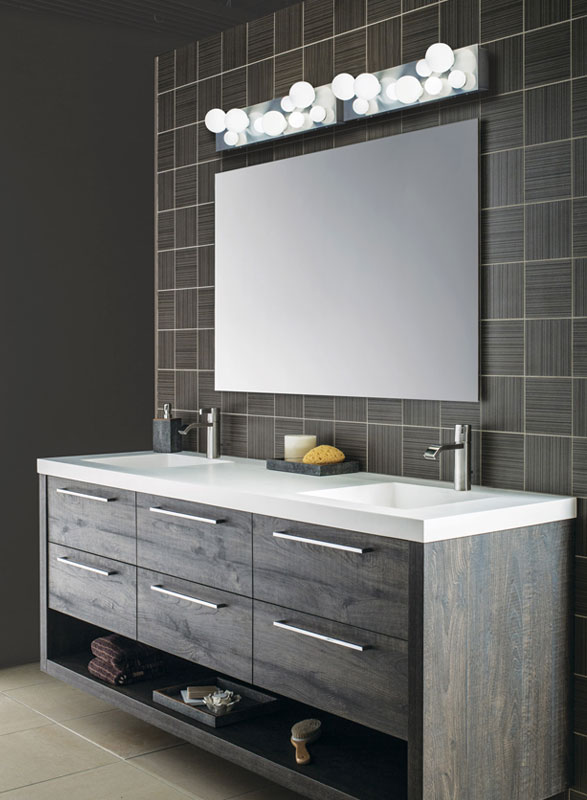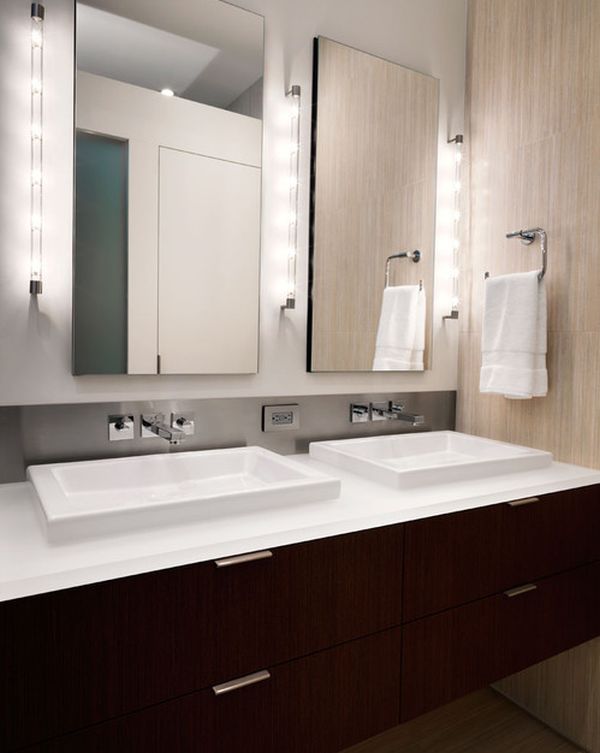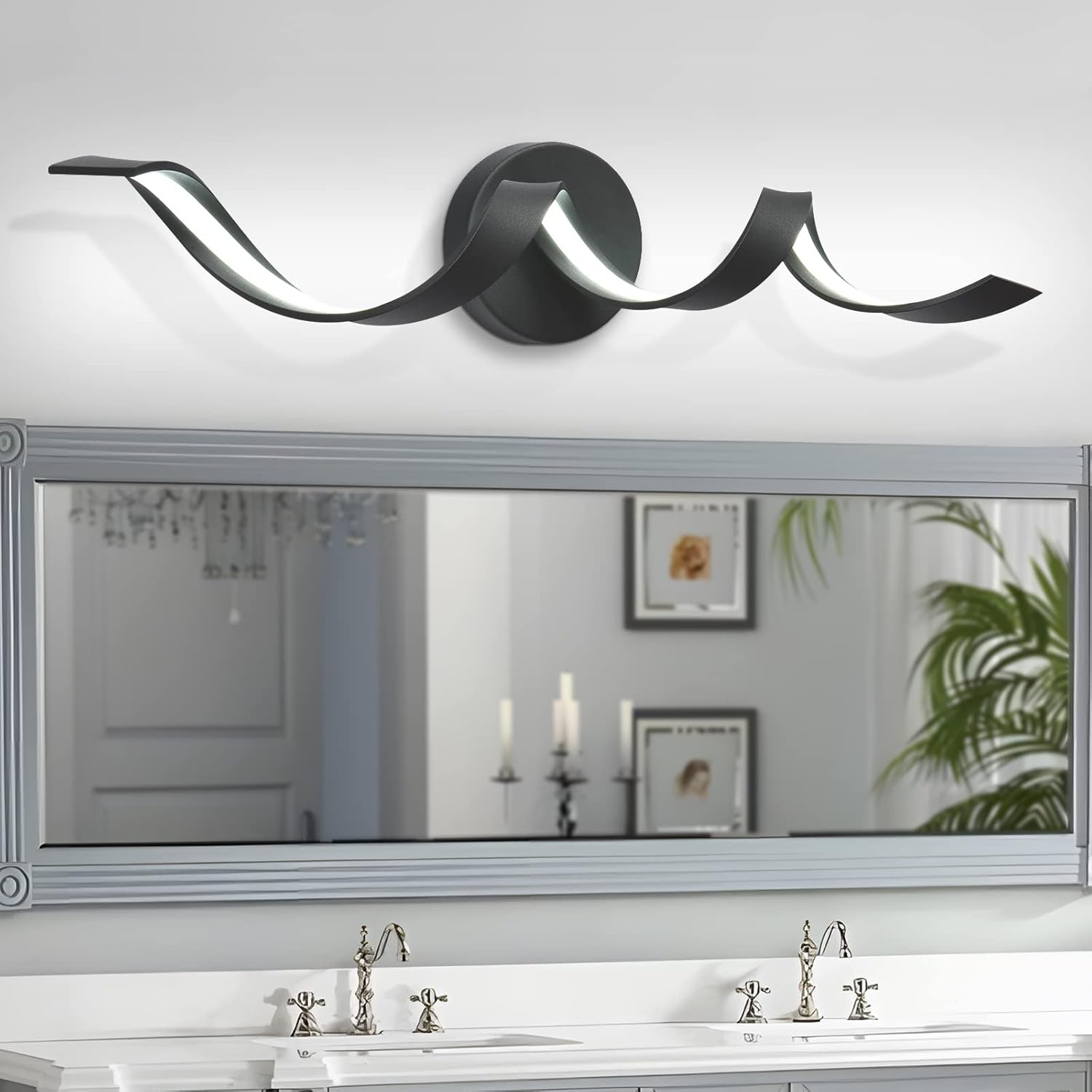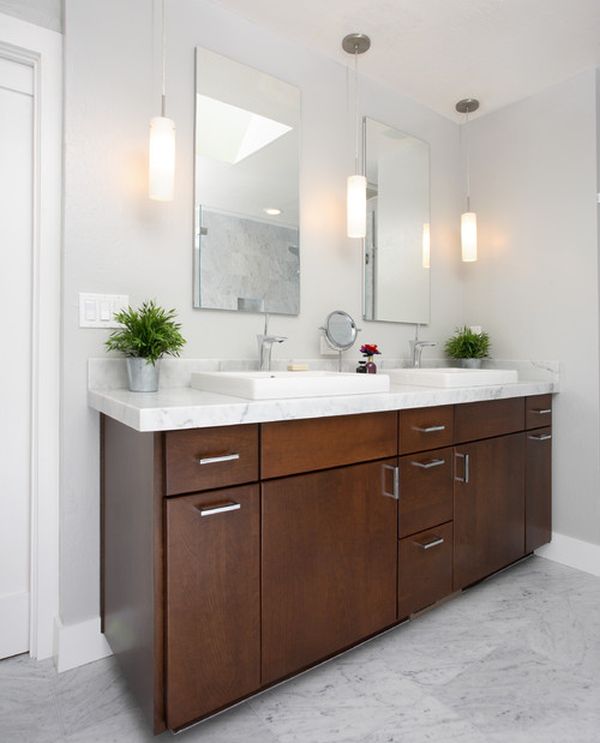Understanding the Importance of Bathroom Vanity Lighting
Bathroom vanity lighting is more than just a functional element; it plays a significant role in the overall design and usability of your bathroom. The right lighting can enhance your daily routines, make your bathroom feel more luxurious, and even boost your home’s value. In this article, we’ll explore why bathroom vanity lighting is essential and how it impacts various aspects of your bathroom experience.
- Enhances Daily Grooming: Proper vanity lighting is essential for tasks such as applying makeup, shaving, and hairstyling. Without adequate lighting, these activities can become difficult and lead to mistakes. Bright, well-positioned lights help eliminate shadows on your face, providing clear visibility for precision grooming.
- Improves Bathroom Aesthetics: The right vanity lighting can significantly improve the aesthetics of your bathroom. It adds a touch of elegance and sophistication, creating a welcoming and warm environment. Whether you prefer a modern, sleek design or a more traditional look, the right lighting can accentuate your bathroom’s style.
- Creates the Right Mood: Lighting sets the mood in any room, and the bathroom is no exception. Vanity lighting can create a calm, spa-like atmosphere perfect for relaxation or a bright, energizing environment to start your day. By choosing the right bulbs and fixtures, you can control the ambiance to suit your needs.
- Increases Home Value: Well-designed bathroom lighting can add value to your home. Potential buyers often pay close attention to bathroom features, and good lighting is a desirable aspect. It can make the space feel more upscale and functional, contributing to a higher overall home valuation.
- Enhances Safety: Proper lighting is also a safety feature. It ensures that you can see clearly, reducing the risk of accidents such as slips and falls. This is particularly important in a bathroom, where wet surfaces can make the environment more hazardous.
- Supports Layered Lighting Design: Vanity lighting is a crucial component of a layered lighting design, which involves using multiple light sources to create a well-lit space. By combining ambient, task, and accent lighting, you can achieve a balanced and versatile bathroom lighting scheme that meets all your needs.

Choosing the Right Type of Vanity Lighting Fixture
Selecting the right type of vanity lighting fixture is essential for achieving the perfect balance between functionality and style in your bathroom. With so many options available, it can be challenging to decide which fixture is best suited for your space. This article will guide you through the different types of vanity lighting fixtures and help you make an informed decision.
Wall-Mounted Sconces: Wall-mounted sconces are a popular choice for vanity lighting. They can be placed on either side of the mirror, providing even illumination across your face. This setup helps eliminate shadows and is ideal for grooming tasks. Sconces come in various styles, from classic to contemporary, allowing you to match them with your bathroom decor.
Overhead Fixtures: Overhead vanity lights are installed above the mirror and provide direct light down onto the vanity area. They are a good option if you have limited wall space on the sides of your mirror. However, be cautious, as overhead lighting alone can create shadows under the eyes and chin, making it less ideal for grooming.
Integrated LED Mirrors: Integrated LED mirrors combine the mirror and light fixture into one unit. The LED lights are usually embedded around the mirror’s perimeter, providing even, shadow-free lighting. These mirrors are a sleek, modern option that works well in minimalist bathroom designs.
Pendant Lights: Pendant lights are a stylish alternative to traditional vanity fixtures. They hang from the ceiling and can be placed on either side of the mirror or in pairs for a dramatic effect. Pendant lights add a decorative element to your bathroom and work well in spaces with high ceilings.
Recessed Lighting: Recessed lights are installed into the ceiling and provide a clean, uncluttered look. They can be used as the primary light source or in conjunction with other fixtures. Recessed lighting is versatile and can be directed to highlight specific areas, but on its own, it may not provide sufficient task lighting.
Under-Cabinet Lighting: If your vanity has cabinets or shelves, under-cabinet lighting can be a functional and aesthetic addition. These lights are installed underneath cabinets to illuminate the countertop. Under-cabinet lighting is particularly useful for tasks like reading labels or finding items in drawers.
How to Position Vanity Lights for Optimal Illumination
The placement of your vanity lights is just as important as the type of fixture you choose. Proper positioning ensures that your bathroom is well-lit, functional, and visually appealing. In this article, we’ll discuss the best practices for positioning vanity lights to achieve optimal illumination.
Positioning at Eye Level: For the most effective lighting, vanity lights should be positioned at eye level. This placement helps eliminate shadows on your face, making tasks like shaving and applying makeup easier. Typically, wall-mounted sconces on either side of the mirror at about 60 to 65 inches from the floor are ideal.
Spacing Between Fixtures: When using multiple fixtures, such as sconces on either side of the mirror, it’s important to space them correctly. Ideally, they should be about 28 to 30 inches apart, depending on the size of the mirror and the available wall space. This spacing ensures even lighting across your face without creating shadows.
Height Considerations for Overhead Lighting: If you’re using an overhead light above the mirror, it should be positioned approximately 75 to 80 inches from the floor. The light should be centered above the mirror to distribute light evenly across the vanity area. Be mindful of the height to avoid creating harsh shadows under the eyes or chin.
Layering with Ambient Lighting: In addition to task lighting around the vanity, consider layering with ambient lighting to create a well-balanced space. Ambient lighting, such as recessed ceiling lights or a central ceiling fixture, should be positioned to fill the room with a soft, general light, complementing the focused illumination of the vanity lights.
Adjusting for Bathroom Size: The size of your bathroom and the placement of other fixtures, like sinks or cabinets, will influence where you position your vanity lights. In smaller bathrooms, you may need to be more creative with your placement, while larger spaces offer more flexibility to experiment with different configurations.
Considering Shadows and Glare: It’s crucial to position your vanity lights to minimize shadows and glare. Lights that are too high or too low can cast unflattering shadows, while poorly positioned lights can cause glare on the mirror. Testing different positions before final installation can help you find the optimal placement.
Exploring Different Styles of Vanity Lighting
Vanity lighting is not just about functionality; it’s also an opportunity to express your style and enhance the overall design of your bathroom. There are many different styles of vanity lighting to choose from, each offering a unique look and feel. In this article, we’ll explore some of the most popular styles of vanity lighting to help you find the perfect fit for your bathroom.
Modern and Minimalist: Modern vanity lighting is characterized by clean lines, simple shapes, and a focus on functionality. Fixtures often feature materials like chrome, glass, or brushed nickel, and may include integrated LED lights for a sleek, streamlined appearance. This style is ideal for contemporary bathrooms with a minimalist design.
Traditional and Classic: Traditional vanity lighting is often more ornate, with fixtures featuring intricate details, curved lines, and decorative elements. Materials like brass, bronze, and frosted glass are common in this style. Traditional lighting works well in bathrooms with a classic or vintage design, adding a touch of elegance and sophistication.
Industrial: Industrial-style vanity lighting takes inspiration from factories and warehouses, featuring exposed bulbs, metal finishes, and a rugged, utilitarian design. This style is perfect for bathrooms with an urban, loft-like feel, and pairs well with elements like concrete, wood, and metal.
Rustic and Farmhouse: Rustic and farmhouse-style vanity lighting is all about warmth and charm. Fixtures often feature natural materials like wood and wrought iron, with designs that evoke a cozy, country feel. This style is ideal for bathrooms with a rustic or farmhouse design, creating a welcoming, homely atmosphere.
Art Deco and Glam: For those who love a touch of glamour, Art Deco-style vanity lighting offers bold, geometric designs, luxurious materials, and a sense of opulence. Fixtures may feature crystal accents, gold finishes, and intricate patterns. This style is perfect for adding a statement piece to a bathroom and works well in both modern and vintage-inspired spaces.
Eclectic and Bohemian: Eclectic and bohemian-style vanity lighting is all about mixing and matching different elements to create a unique, personalized look. This style allows for a lot of creativity, with fixtures in various colors, shapes, and materials. It’s ideal for those who want to express their individuality and create a truly one-of-a-kind bathroom.
Incorporating Layered Lighting for a Balanced Bathroom Look
Creating a well-lit bathroom involves more than just choosing the right vanity lights; it’s about incorporating layered lighting to achieve a balanced and functional space. Layered lighting combines ambient, task, and accent lighting to ensure that every part of your bathroom is well-illuminated and serves its purpose. In this article, we’ll discuss how to incorporate layered lighting into your bathroom design.
Ambient Lighting as the Foundation: Ambient lighting is the general, overall lighting in your bathroom, providing the base layer of illumination. It’s usually achieved through ceiling fixtures like recessed lights, chandeliers, or flush mounts. Ambient lighting should be soft and diffuse, creating a comfortable environment without harsh shadows or glare.
Task Lighting for Focused Illumination: Task lighting is focused lighting that illuminates specific areas where activities like grooming, makeup application, or shaving take place. Vanity lights are a key component of task lighting, providing bright, even light that eliminates shadows on your face. Task lighting should be strategically placed to ensure you have enough light for precision tasks.
Accent Lighting for Decorative Highlights: Accent lighting adds depth and dimension to your bathroom by highlighting architectural features, artwork, or other focal points. This type of lighting is usually softer and more focused than ambient or task lighting. Examples of accent lighting include wall sconces, under-cabinet lights, or LED strips around mirrors or shelving.
Combining Layers for Balance: To achieve a balanced look, it’s important to combine ambient, task, and accent lighting in a way that complements each other. The goal is to create a space that is both functional and visually appealing. For example, ambient lighting sets the mood, task lighting ensures you can see clearly while grooming and accent lighting adds character and warmth.
Dimming Options for Versatility: Incorporating dimmable fixtures in your layered lighting design allows you to adjust the brightness to suit different activities and moods. For example, you can have bright task lighting for morning routines and dimmer ambient lighting for a relaxing bath in the evening. Dimming options provide flexibility and help create a dynamic, adaptable space.
Considering the Size and Layout of Your Bathroom: The size and layout of your bathroom will influence how you layer your lighting. In larger bathrooms, you may need more ambient lights and multiple task lights, while smaller bathrooms may require fewer fixtures. Consider how natural light enters the space and how different light sources will interact to create a cohesive design.
Energy Efficiency and Bathroom Vanity Lighting
Energy efficiency is an important consideration when choosing bathroom vanity lighting. Not only does it help reduce your electricity bills, but it also minimizes your environmental impact. With advancements in lighting technology, there are many energy-efficient options available that don’t compromise on style or brightness. In this article, we’ll explore how to make your bathroom vanity lighting more energy-efficient.
Choosing LED Bulbs: LED bulbs are the most energy-efficient option for bathroom vanity lighting. They use significantly less energy than traditional incandescent bulbs and have a much longer lifespan, reducing the need for frequent replacements. LED bulbs are available in various color temperatures, so you can choose the right one to match your bathroom’s ambiance.
Installing Motion Sensors: Motion sensors are a smart way to save energy in the bathroom. They automatically turn the lights on when someone enters the room and off when the room is unoccupied. This feature is particularly useful for vanity lighting, as it ensures the lights are only on when needed, reducing unnecessary energy consumption.
Using Dimmers: Dimmers allow you to adjust the brightness of your vanity lights, which can help save energy and extend the life of your bulbs. By reducing the light output when full brightness is not needed, you can lower your energy usage. Dimmers also add versatility to your bathroom lighting, allowing you to create different moods and atmospheres.
Selecting Energy-Efficient Fixtures: When choosing vanity lighting fixtures, look for those that are designed to be energy-efficient. Many modern fixtures are built with energy-saving features, such as integrated LED lights, which are more efficient than traditional fixtures that require separate bulbs. These fixtures often have a sleeker design and provide even, consistent lighting.
Maximizing Natural Light: Maximizing natural light is an effective way to reduce your reliance on artificial lighting. If your bathroom has windows, consider how you can make the most of the natural light during the day. This might involve choosing lighter paint colors, installing mirrors to reflect light, or using sheer window treatments that let in plenty of daylight.
Regular Maintenance for Efficiency: Keeping your vanity lights clean and well-maintained can also contribute to energy efficiency. Dust and dirt can reduce the effectiveness of your light fixtures, making them appear dimmer and causing you to use more lights or higher settings than necessary. Regular cleaning and replacing old or inefficient bulbs will ensure your bathroom lighting remains bright and efficient.
Customizing Vanity Lighting to Match Your Bathroom Aesthetic
Your bathroom’s lighting should complement its overall design, reflecting your style and enhancing the space’s aesthetic appeal. Customizing your vanity lighting allows you to create a cohesive look that ties together all the elements of your bathroom. In this article, we’ll explore how to customize your vanity lighting to match your bathroom aesthetic.
Matching Fixture Finishes The finish of your vanity lighting fixtures should complement the other hardware and fixtures in your bathroom. For example, if you have chrome faucets and towel bars, choose vanity lights with a chrome finish to create a cohesive look. Matching finishes help create a unified design and ensure that all elements work together harmoniously.
Coordinating with Color Schemes Your vanity lighting should coordinate with your bathroom’s color scheme. For a monochromatic look, choose fixtures that blend seamlessly with the wall color. For a more dynamic design, select lighting that contrasts with the walls or complements other accent colors in the room. Consider how the color of the light itself, whether warm or cool, will affect the overall color scheme.
Incorporating Unique Design Elements Customizing your vanity lighting can involve incorporating unique design elements that reflect your personal style. This might include choosing fixtures with decorative details, such as intricate metalwork, colored glass shades, or artistic designs. These elements can make your vanity lighting a focal point in the bathroom.
Adjusting Lighting for Different Aesthetics Different bathroom styles call for different lighting approaches. For a modern, minimalist bathroom, opt for sleek, understated fixtures with clean lines. In a vintage or traditional bathroom, ornate fixtures with antique finishes can add a touch of elegance. Rustic or farmhouse bathrooms might benefit from lighting with natural materials like wood or iron.
Personalizing with Accessories Personalizing your vanity lighting doesn’t have to stop at the fixtures themselves. Consider adding accessories, such as decorative light switch covers, dimmer knobs, or even customized bulb shades. These small details can add personality and charm to your bathroom, making it feel more tailored to your taste.
Considering the Overall Design Flow When customizing your vanity lighting, it’s essential to consider how it fits into the overall design flow of your bathroom. The lighting should not only complement the style but also enhance the functionality and atmosphere of the space. By carefully selecting fixtures, finishes, and lighting types, you can create a bathroom that is both beautiful and practical.
Bathroom Vanity Lighting Ideas to Brighten Up Your Mornings
Lighting Up the Bathroom with Bathroom Vanity Lighting
Dimmable Modern LED Bathroom Vanity Lights 24 inch
Bathroom Vanity Lighting Ideas to Brighten Up Your Mornings
Designers Fountain 24 in. Elliott 3-Light Matte Black Industrial
Bathroom Lighting Ideas – Best Bathroom Vanity Lighting Ideas
Related Posts:
- Typical Bathroom Vanity Height
- Bathroom Vanity No Backsplash
- Bathroom Vanity Sets Discount
- 57 Inch Bathroom Vanity
- Log Bathroom Vanity
- Bathroom Vanity Lights Black Finish
- Bathroom Vanity Dimensions Cabinets
- Solid Wood Bathroom Vanities Made In USA
- 22 Inch Wide Bathroom Vanity
- Bathroom Vanity Double Sink Tops
